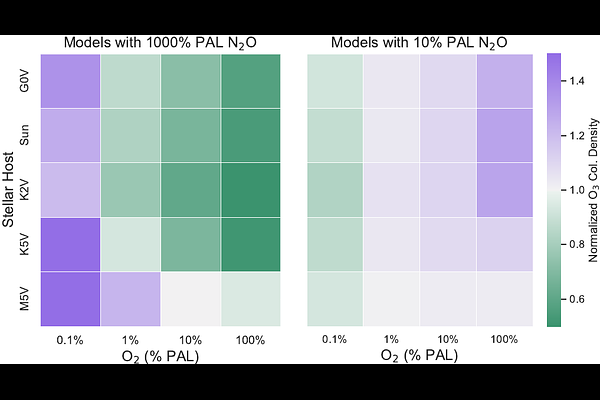Is Ozone a Reliable Proxy for Molecular Oxygen? II. The impact of N$_2$O on the O$_2$-O$_3$ relationship for Earth-like atmospheres

Is Ozone a Reliable Proxy for Molecular Oxygen? II. The impact of N$_2$O on the O$_2$-O$_3$ relationship for Earth-like atmospheres
Thea Kozakis, João M. Mendonça, Lars A. Buchhave, Luisa M. Lara
AbstractMolecular oxygen (O2) will be an important molecule in the search for biosignatures in terrestrial planetary atmospheres in the coming decades. In particular, O2 combined with a reducing gas is thought to be strong evidence for disequilibrium caused by surface life. However, there are circumstances where it would be very difficult or impossible to detect O2, in which cases it has been suggested that ozone (O3), the photochemical product of O2, could be used instead. Unfortunately, the O2-O3 relationship is highly nonlinear and dependent on the host star, as shown in detail in the first paper in this series. We explore the O2-O3 relationship around G0V-M5V host stars, using climate/photochemistry modeling to simulate atmospheres while varying abundances of O2 and nitrous oxide (N2O). N2O is of particular importance to the O2-O3 relationship not just because it is produced biologically, but because it is the primary source of nitrogen oxides (NOx), which fuel the NOx catalytic cycle which destroys O3, and the smog mechanism that produces O3. We vary the O2 mixing ratio from 0.01-150% present atmospheric level (PAL), and N2O abundances of 10% and 1000% PAL. We find that varying N2O impacts the O2-O3 relationship differently depending strongly on both the host star and the amount of atmospheric O2. Planets orbiting hotter hosts with strong UV fluxes efficiently convert N2O into NOx, often depleting a significant amount of O3 via faster NOx catalytic cycles. However, for cooler hosts and low O2 levels we find that increasing N2O can lead to an increase of overall O3 due to the smog mechanism producing O3 in the lower atmosphere. Variations in O3 result in significant changes in the amount of harmful UV reaching the surfaces of the model planets as well as the strength of the 9.6 $\mu$m O3 emission spectral feature, demonstrating potential impacts on habitability and future observations.